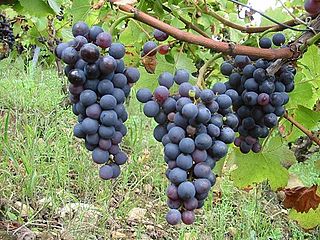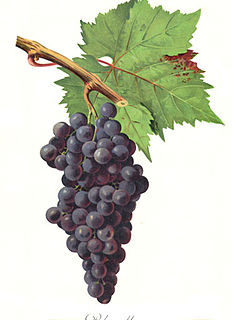Related Research Articles

Folle blanche, also known as Picpoule, Gros Plant, and Enrageat blanc, is a wine grape variety from southwest France. It was the traditional grape variety in Cognac and Armagnac production until the 20th century. Folle blanche is an offspring of Gouais blanc, with the other parent so far unidentified.

Aligoté is a white grape used to make dry white wines, especially in the Burgundy region of France where it was first recorded in the 18th century. Since it is tolerant to cold, this variety is also cultivated in Eastern European countries. In 2004, it was the 22nd most planted vine variety in the world at 45,000 hectares.

Gouais blanc or Weißer Heunisch is a white grape variety that is seldom grown today but is important as the ancestor of many traditional French and German grape varieties. The name Gouais derives from the old French adjective ‘gou’, a term of derision befitting its traditional status as the grape of the peasants. Likewise, the German name Weißer Heunisch labels it as one the lesser "Hunnic" grapes.

Poulsard is a red French wine grape variety from the Jura wine region. The name Ploussard is used mainly around the town of Pupillin but can appear on wine labels throughout Jura as an authorized synonyms. While technically a dark-skinned noir grape, the skins of Poulsard are very thin with low amounts of color -phenols and produces very pale colored red wines, even with extended maceration and can be used to produce white wines. Because of this, Poulsard is often blended with other red-skin varieties or used to produce lightly colored rosé wines. Additionally the grape is used to make blanc de noir white wines and sparkling cremants.
Tibouren or Rossese di Dolceacqua is a red French wine grape variety that is primarily grown in Provence and Liguria but originated in Greece and possibly even the Middle East. Intensely aromatic, with an earthy bouquet that wine expert Jancis Robinson describes as garrigue, Tibouren is often used in the production of rosés.

Aramon or Aramon noir is a variety of red wine grape grown primarily in Languedoc-Roussillon in southern France. Between the late 19th century and the 1960s, it was France's most grown grape variety, but plantings of Aramon have been in continuous decline since the mid-20th century. Aramon has also been grown in Algeria, Argentina and Chile but nowhere else did it ever reach the popularity it used to have in the south of France.
Villard grapes are French wine hybrid grape created by French horticulturist Bertille Seyve and his father-in-law Victor Villard. They include the dark skin Villard noir and the white-wine variety Villard blanc with both being members of the Seyve-Villard grape family. Villard noir is a cross of two other French hybrids, Siebel 6905 and Seibel 7053 created by physician and plant breeder Albert Seibel. Like Villard noir, Villard blanc was produced as a crossing of two Seibel grapes, in this case, Le Subereux and Seibel 6468.

Calitor or Calitor noir is a red French wine grape variety. It was previously widely cultivated in southern France, in particular in Provence, but is now very rare, almost extinct. Historically used as mainly a blending variety, Calitor gives high yields and produces a light-bodied and lightly colored wine. When grown on hillside sites, it can give a wine of character.
Jurançon is the name attributed to a red and white French wine grape variety that is grown predominantly in Southwest France. According to wine expert Jancis Robinson, both colors produce wines of average to low quality.
Aubin vert is a white French wine grape variety that is grown in the Lorraine region where it is an authorized variety for the Appellation d'Origine Contrôlée (AOC) wines of the Moselle. While often confused for the Côtes de Toul grape Aubin blanc, DNA analysis in 1999 showed that Aubin vert was the result of a crossing of Gouais blanc with Pinot. This makes the grape a half-sibling to Aubin blanc but full sibling to Chardonnay, Aligoté, Gamay and Melon de Bourgogne.
Enfariné noir is a red French wine grape variety that is grown predominantly in the Jura wine region of eastern France. Despite being known under the synonym Gouais noir in the Aisne, Aube, Marne, Meuse and Seine-et-Marne departments, the grape has no known connection to the Gouais blanc wine grape that is the parent of several wine grape varieties such as Chardonnay, Gamay and Melon de Bourgogne. While once widely planted throughout the Franche-Comté, the grape is now nearly extinct with less than 1 hectare of the variety planted in 2008.
Béquignol noir is a red French wine grape variety that originated in Southwest France but is now more widely grown in the Mendoza wine region of Argentina where it is often used to add color to blends. The grape is often confused with several other red wine varieties such as Cabernet Franc, Durif, Fer and Prunelard with Béquignol noir sharing several synonyms with these grapes. However DNA profiling has shown Béquignol noir to be distinct from those grape varieties. Further research in 2011 showed that Béquignol noir may have a parent-offspring relationship with the Savagnin grape.

Gouget noir is a red French wine grape variety that is grown in the Allier and Cher departments of central France. The grape was once widely planted with almost 17,000 hectares in the mid-19th century but the phylloxera epidemic greatly diminished it numbers and as of 2008 there was just 10 hectares of the grape planted in France.
Camaraou noir is a red French wine grape variety that was historically grown in South West France but is now more widely planted in the Spanish wine region of Galicia where it is known as Espadeiro. However, despite its Spanish synonym Camaraou noir has no relationship to the Portuguese wine grape Espadeiro that is used to make red Vinho Verde. The grape may have some relation to the Jurançon and Béarn wine grape Camaralet de Lasseube which is also known as Camaraou blanc but DNA analysis has shown that the two varieties are distinct and not color mutations of one or the other.
Bouteillan noir is a red French wine grape variety that is grown in the Provence wine region of southern France. While the grape has been recorded growing in the Vaucluse region since at least the early 18th century, today the grape is virtually extinct. Despite sharing synonyms with another Provençal grape, Calitor, and the Languedoc wine grape Aramon noir, Bouteillan noir has no known relationship with either of those variety. The white Provençal grape Colombaud was once thought to be a white berried color mutation of Bouteillan noir but research conducted by Dr. Linda Bisson of the University of California, Davis shows that while the two grapes are likely related, one is not a color mutation of the other.
Canari noir is a red French wine grape variety that has been historically grown in the Ariège department in the foothills of the French Pyrénées. However DNA profiling in 2001 showed that plantings of a grape called Gamay Luverdon growing in the Italian wine region of Piedmont were in fact plantings of Canari noir. Across the Pyrénées in Spain, the grape variety known as Batista was also found to be identical to Canari noir. Like Pinot noir and Grenache, Canari noir has color mutations known as Canari blanc and Canari gris.
Gueuche noir is a red French wine grape variety that has been historically grown in the Franche-Comté of eastern France but is now close to being extinct. Though its exact relationship has not yet been determined by DNA analysis, ampelographers believe that the grape variety is closely related to the Hunnic grape Gouais blanc which is notable for being the mother vine to several grape varieties including Chardonnay and Gamay. There also might be a relationship between Gueuche noir and the Jura wine grape Enfariné noir.
Mauzac noir is a red French wine grape variety that is grown in Southwest France. Despite the similarities in name, Mauzac noir is not a color mutation of the white Limoux wine grape Mauzac that is an important component in the Appellation d'origine contrôlée (AOC) sparkling wine Blanquette de Limoux. Today Mauzac noir is nearly extinct but at least one grower in the Gaillac AOC is attempting to revive the variety and make varietal examples of the grape.
Mornen noir is a red French wine grape variety that was historically grown in both the Rhône and Loire departments but is today only found in very limited plantings around the commune of Chavanay. It was thought that the grape was also to be found growing in Hungary under the names Kékmedoc and Medoc noir, but DNA analysis has confirmed that the Hungarian plantings are actually a separate variety now known as Menoir
Arrouya noir is a red French wine grape variety grown in the Jurançon region of Southwest France. The grape has a long history in the region, growing in the Pyrénées-Atlantiques since at least the late 18th century. Ampelographers believe that Arrouya noir has some genetic relationship with Camaraou noir, Fer and Petit Courbu though the exact nature of those relationships is not yet known. The variety also shares some similarities in morphology with Cabernet Franc and until the late 19th century was often confused for the Loire and Bordeaux wine grape, especially in the Basses-Pyrénées and Hautes-Pyrénées region.
References
- ↑ J. Robinson Jancis Robinson's Guide to Wine Grapes pg 42 Oxford University Press 1996 ISBN 0-19-860098-4
- ↑ J. Robinson, J. Harding and J. Vouillamoz Wine Grapes - A complete guide to 1,368 vine varieties, including their origins and flavours pgs 179-180, Allen Lane 2012 ISBN 978-1-846-14446-2